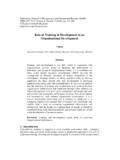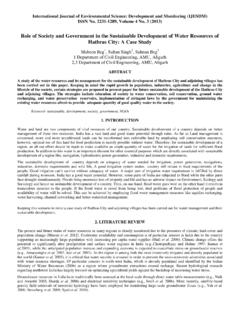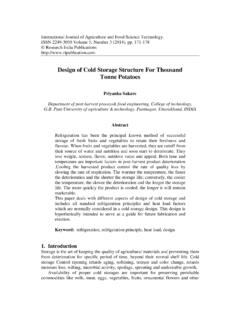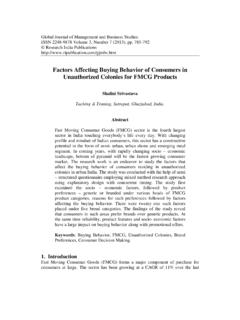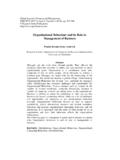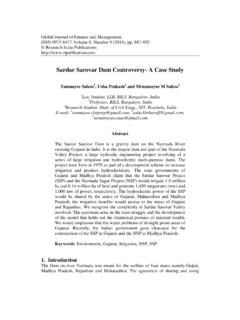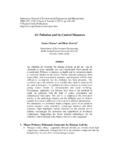Transcription of Types of Hacking Attack and their Counter Measure
1 International Journal of Educational Planning & Administration. Volume 1, Number 1 (2011), pp. 43-53 Research India Publications Types of Hacking Attack and their Counter Measure Minakshi Bhardwaj and Singh Galley discusses three Types of attacks against computer systems: Physical, Syntactic and Semantic. A physical Attack uses conventional weapons, such as bombs or fire. A syntactic Attack uses virus-type software to disrupt or damage a computer system or network. A semantic Attack is a more subtle approach. Its goal is to Attack users' confidence by causing a computer system to produce errors and unpredictable results. Syntactic attacks are sometimes grouped under the term "malicious software" or "malware". These attacks may include viruses, worms, and Trojan horses.
2 One common vehicle of delivery formal ware is email. Semantic attacks involve the modification of information or dissemination of incorrect information. Modification of information has been perpetrated even without the aid of computers, but computers and networks have provided new opportunities to achieve this. Also, the dissemination of incorrect information to large numbers of people quickly is facilitated by such mechanisms as email, message boards, and websites Hacking tricks can be divided into different categories elaborated below: 1. Trojan programs that share files via instant messenger. 2. Phishing 3. Fake Websites. 4. Spoofing 5. Spyware 6. Electronic Bulletin Boards 7. Information Brokers 8. Internet Public Records 9. Trojan Horses 10.
3 Wormhole Attack Trojan programs that share files via instant messenger Instant messaging allows file-sharing on a computer. All present popular instant messengers have file sharing abilities, or allow users to have the above functionality by installing patches or plug-ins; this is also a major threat to present information security. These communication software also make it difficult for existing hack prevention method to prevent and control information security. Hackers use instant communication capability to plant Trojan program into an unsuspected program; the planted program is a kind of remotely controlled Hacking tool that can conceal itself and is unauthorized. The Trojan program is unknowingly executed, controlling the 44 Minakshi Bhardwaj and Singh infected computer; it can read, delete, move and execute any file on the computer.
4 The advantages of a hacker replacing remotely installed backdoor Trojan programs with instant messengers to access files are: When the victim gets online, the hacker will be informed. Thus, a hacker can track and access the infected computer, and incessantly steal user information. A hacker need not open a new port to perform transmissions; he can perform his operations through the already opened instant messenger port. Even if a computer uses dynamic IP addresses, its screen name doesn't change. Hijacking and Impersonation There are various ways through which a hacker can impersonate other users. The most commonly used method is eavesdropping on unsuspecting users to retrieve user accounts, passwords and other user related information.
5 The theft of user account number and related information is a very serious problem in any instant messenger. For instance, a hacker after stealing a user's information impersonate the user; the user's contacts not knowing that the user's account has been hacked believe that the person they're talking to is the user, and are persuaded to execute certain programs or reveal confidential information. Hence, theft of user identity not only endangers a user but also surrounding users. Guarding against Internet security problems is presently the focus of future research; because without good protection, a computer can be easily attacked, causing major losses. Hackers wishing to obtain user accounts may do so with the help of Trojans designed to steal passwords.
6 If an instant messenger client stores his/her password on his/her computer, then a hacker can send a Trojan program to the unsuspecting user. When the user executes the program, the program shall search for the user's password and send it to the hacker. There are several ways through which a Trojan program can send messages back to the hacker. The methods include instant messenger, IRC, e-mails, etc. Current four most popular instant messengers are AIM, Yahoo! Messenger, ICQ, and MSN Messenger, none of which encrypts its flow. Therefore, a hacker can use a man-in-the-middle Attack to hijack a connection, then impersonate the hijacked user and participate in a chat-session. Denial of Service There are many ways through which a hacker can launch a denial of service (DoS) Attack on an instant messenger user.
7 A Partial DoS Attack will cause a user end to hang, or use up a large portion of CPU resources causing the system to become unstable. There are many ways in which a hacker can cause a denial of service on an instant messenger client. One common type of Attack is flooding a particular user with a large number of messages. The popular instant messaging clients contain protection against flood- attacks by allowing the victim to ignore certain users. However, there are many tools that allow the hacker to use many accounts simultaneously, or automatically create a large number of accounts to accomplish the flood- Attack . Adding to this is the Types of Hacking Attack and their Counter Measure 45 fact that once, the flood- Attack has started and the victim realizes what has happened, the computer may become unresponsive.
8 Therefore, adding the attacking user accounts to the ignore list of the instant messenger client may be very difficult DoS attacks are very easy to generate and very difficult to detect, and hence are attractive weapons for hackers. In a typical DoS Attack , the attacker node spoofs its IP address and uses multiple intermediate nodes to overwhelm other nodes with traffic. DoS attacks are typically used to take important servers out of action for a few hours, resulting in DoS for all users served by the server. It can also be used to disrupt the services of intermediate routers. Phishing The word phishing comes from the analogy that Internet scammers are using email lures to fish for passwords and financial data from the sea of Internet users.
9 The term was coined in 1996 by hackers who were stealing AOL Internet accounts by scamming passwords from unsuspecting AOL users. Since hackers have a tendency to replacing f' with ph the term phishing was derived. Phishing is a method that exploits people's sympathy in the form of aid-seeking e-mails; the e-mail act as bait. These e-mails usually request their readers to visit a link that seemingly links to some charitable organization's website; but in truth links the readers to a website that will install a Trojan program into the reader's computer. Therefore, users should not forward unauthenticated charity mails, or click on unfamiliar links in an e-mail. Sometimes, the link could be a very familiar link or an often frequented website, but still, it would be safer if you'd type in the address yourself so as to avoid being linked to a fraudulent website.
10 Phisher deludes people by using similar e-mails mailed by well-known enterprises or banks; these e-mails often asks users to provide personal information, or result in losing their personal rights; they usually contain a counterfeit URL which links to a website where the users can fill in the required information. People are often trapped by phishing due to inattention. Phishing Techniques Phishing techniques can be divided into different categories, some of which are elaborated below: Link manipulation Most methods of phishing use some form of technical deception designed to make a link in an email (and the spoofed website it leads to) appear to belong to the spoofed organization. Misspelled URLs or the use of sub domains are common tricks used by phishers, such as this example URL, Another common trick is to make the anchor text for a link appear to be valid, when the link actually goes to the phishers' site.
